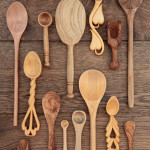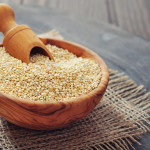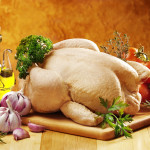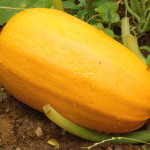Equipment In The Well-Stocked Kitchen
A Great Stand Mixer
This is at the top of our list of important items and probably the most expensive piece of equipment we have. After doing a lot of research, we decided on a Bosch Universal Plus Mixer. It has an 800-watt motor, which means it is powerful enough to do just about anything we need it to do. The mixer bowl latches onto the base and remains stationery while the beaters revolve around the bowl, unlike conventional mixers. It comes with two types of beaters—standard and dough hooks. It is ingeniously designed with a cover that completely seals the top of the mixer bowl—a feature I especially like. We opted to get a food processor attachment to our Bosch that will chop, slice, and shred at the twist of a button. The bowl part of the unit is smaller and also works perfectly for mixing small amounts that could get lost in the larger mixer bowl. In addition, the food processor attachment to the Bosch is the only unit we found that grinds seeds and nuts for butters. This is an important staple in our diet, as even the best brands of sunbutter contain some form of sugar, which Kris cannot tolerate. We buy seeds and nuts and make our own butters, which taste far better than any we have found in jars.
Handheld Mixer
Small, handheld mixers are a wonderful invention and can be used in a multitude of situations where a large, stand mixer just won’t work. There’s no need to search out the most expensive model or brand. One from a discount store will probably last you ten years if you treat it right.
Blender
We use our blender often, and, since we have a separate food processor, we feel no need to buy an exotic or expensive blender. Even the best blender has its limitations, so don’t try to use it for something it’s not designed to do, like grinding seeds. I admit to being a slow learner and have trashed two blenders that way. There are two styles of blenders: one has a center piece in the cover that can be removed for pouring liquids directly into the center of the blades, and one with an offset cover. Most of the time, the style makes no difference, unless you’re making something like mayonnaise, which requires oil to be poured slowly directly into the center.
Mini Food Processor
I was first introduced to mini food processors when my mother gave me one as a Christmas gift. At that time, I wasn’t into cooking and didn’t know the difference between a blender and a juicer. Over the years, I realized how useful and easy to use this small appliance was, and continued to use my gift over 20 years until it died. We now have a much newer version and use it for chopping vegetables in a fraction of the time it would take to set up a full-sized food processor. We especially appreciate it for tear-free onion chopping.
Measuring Spoons
There are numerous types and shapes of measuring spoons on the market and not all of them are created equally. The most common are stainless steel spoons that are broad and flat. Another type is often plastic with round, chunky spoons. These all have their use but don’t fit well in spice jars, which I find really annoying. Our favorite set is stainless steel with narrow, elongated rectangular spoons that fit well into spice and herb jars. The beauty of these measuring spoons is that a set contains 1/8, 1/4, 1/2, 3/4, 1 teaspoon and 1 tablespoon. We suggest you buy multiple sets of measuring spoons, as there are times when you need a tablespoon measure for a wet ingredient and a tablespoon measure for a dry ingredient in the same recipe.
Wooden Spoons
We keep wooden spoons handy by storing them upright in a small crock on the countertop. We have varying sizes, from oriental soupspoon size to a large bamboo spoon. Most spoons are raw wood or untreated, and require “seasoning” before using. Please refer to the formula for curing wooden utensils in the “How To” section of this Site.
Dry Measure Cups
Like measuring spoons, these come in many shapes and configurations. Multiple sets are the key here—we have four sets and never have to stop and wash a cup. Try to get at least one set that has a configuration of 1/4, 1/3, 1/2, 2/3, 3/4, and 1 cup.
Wet Measure Cups
The most common kind you will see is Pyrex in one cup, two cup, four cup, or larger sizes. We have a glass bowl with a handle and markings on the side that holds nine cups and doubles as a mixer bowl. Choose sizes that work for your cooking style, and keep them together in a convenient place.
Strainers
We have multiple strainers in many shapes and sizes. Each one has its usefulness and best purpose, depending on the strainer size and the hole sizes in the strainer. You can find strainers in department stores, high end cooking stores, grocery stores, and even dollar stores, and this is an investment that won’t break the bank. Find a variety that suit your needs, and keep them in a handy location in your kitchen.
Splatter Screen
This is a large, flat-screened disk with a handle. The mesh is a tight weave and especially useful for straining washed grains and rices. Quinoa is a tiny grain that slips right through strainers, except for the splatter screen. For this purpose alone, it’s worth the small investment. However, since it’s made of stainless steel, it’s best not to run it through your dishwasher as, in a short time, it may rust.
Rubber Scrapers aka Rubber Spatulas
Of all the things in our kitchen, we use rubber spatulas more than anything else. They come in all sizes and shapes, rigid, soft, short, long, large, small, flat, and contoured. Our mixer bowl came with a rigid spatula specifically designed to fit the bowl’s curvature, but, for most purposes, we use small spatulas that are about 3” long on a long handle. Because I generally have my hands full when I realize I need a spatula, we have them conveniently placed on the two counters where we do our mixing. Spatulas are inexpensive items that can be found in a variety of stores, including dollar stores, so stock up with a minimum of 6 to 12. Rubber spatulas can be run through your dishwasher, and, if the plastic head can be easily removed from the handle, be sure to remove the head before washing. Bacteria and mold can find ways into that area and get pretty ugly.
Garlic Press
This little gadget is an essential item in our kitchen. You’ll find several designs in various brands, but they all work about the same way. We have two presses that both hold a large garlic clove and one that will hold several cloves. If you have pain in your hands, go for the smaller size, as the larger press requires a lot of pressing power. If you are new to cooking with fresh garlic, don’t be intimidated. Fresh garlic is so much better than dried or even jarred garlic and is incredibly easy to use with outstanding results. Fresh garlic also stores well at room temperature for several weeks.
Cutting Boards
The number and type of cutting boards you choose depends on your personal preference for cutting surfaces, availability of storage space, whether it fits into your dishwasher, counter space, and probably a few other factors I haven’t mentioned. We have various sizes of wooden boards, hard plastic boards, and, my favorite, a large piece of Corian I bought at a flea market from a vendor who made it out of the cutouts from kitchen counters. My next favorite is a rigid plastic board that has a fairly large surface but still fits in the dishwasher. You will need a minimum of two boards at any given time. When making a meal that has meat, poultry or fish, be sure to use a separate board for cutting vegetables to avoid cross contamination of bacteria. Wooden boards are generally purchased as raw wood and need to be treated or “seasoned” before use. If you buy the best boards and treat them well, you’ll be able to pass them down to your grandchildren. If you or your spouse are handy in the workshop and plan to make your own cutting boards, choose your wood carefully. Tightly grained hardwoods with small pores such as birch, maple, walnut, beech, mahogany, or cherry are best for reducing scoring of the cutting surface and absorption of liquid and bacteria into the surface. Although oak is a hardwood, it has large pores that retain bacteria, even after washing, making it a poor choice for this purpose. (Baylor) (Allen) Teak, however, “offers a unique combination of functionality, elegance, and carefree maintenance. Teak wood boasts a naturally high level of oily resins, which gives the hardwood its trademark ability to repel moisture, warping, and other signs of aging.” (Proteak) Although bamboo is technically a grass and “not a tree, it grows at a much quicker rate than any other wood. From start to harvest (60 to 70 feet tall), it can take just four years. Bamboo is naturally anti-microbial, therefore stopping bacteria from growing. It is also one of the strongest yet lightest materials around. Bamboo is 16% stronger than Maple and is 33% lighter in weight than Oak.” (Core Bamboo) Do some research and select wood with care, especially if are using a tropical hardwood, as some species contain toxins or allergens. In any case, refer to the formula for curing wooden utensils in the “How To” section to make wooden items last forever.
Mini Muffin Pans
Mini muffin pans are great for making candies. Thankfully, there are also mini muffin papers to be found in most grocery stores. Invest in a set of nonstick pans and resist the urge to run them through the dishwasher. It degrades the finish and causes rust.
Standard Muffin Pans
Good nonstick muffin pans are a must, and, unless you bake for a troop, two pans that will result in two dozen muffins should work. It pays to invest in good muffin pans and then treat them with respect. Never run muffin pans through the dishwasher, and be careful not to scratch the surface of the pans with metal utensils. Be sure to read the small print on the packaging on your new muffin pan as well. I ruined a pan by using commercial nonstick spray, not realizing it would remove the finish, which is a good reason to use oil instead. If nonstick spray can mess up my favorite muffin pan, it can’t be good for a fragile body.
Muffin Paper Liners
Muffin paper liners are found in grocery stores. Keep a supply on hand, and use them liberally for anything you want to come out of a muffin pan easily. We always grease papers before filling them, but, even so, we have discovered that some breads and cakes will stick to the papers when hot but are completely “peelable” when the baked goods are cooled. These make clean up so much easier and allow baked goods to be easily carried in a lunch box.
Misto® Oil Sprayer
At one point, there was only one store brand of nonstick spray that did not have soy in it. Not too many months later, the manufacturer changed the formula and we could no longer use it without Kris and Jonathan getting sick. A reasonable alternative is a Misto Oil Sprayer. Fill the brushed steel canister with your favorite oil, pump the lid, and spray on pans to prevent sticking. We have one for olive oil and one for canola.
Cutlery Set
A set of good cutlery is essential if you’re going to spend quality time in your kitchen, or if you want to spend less time in your kitchen. There are many great brands, and prices range from inexpensive to chef’s grade quality that will make a serious dent in your 401k. The key to choosing knives is in how they feel in your hand. Go to a good cooking store and talk with a salesperson who knows about knives. He or she can guide you into the best choice. When you put the knife in your hand, it should feel like an extension of your hand, and not an awkward intruder. Some knife sets come in a wooden storage block but, if yours doesn’t, it’s a good investment. Setting the block in a convenient location on your countertop is a great way to store your knives and also helps keep your knives sharp. Turn the cutting block if necessary so knife blades can be inserted horizontally or with the blade up to minimize dulling the knives. You will need at least one chef’s knife: the kind with a curved blade. There’s an art to cutting and chopping, and, if you’re new to this part of the prep process, watch some real chefs on TV in a good cooking program, or check your local library for a video on using knives. Take note of the ways they use knives and the rocking motion to make accurate cuts. You’ll also notice if the knife is being held in the right hand, the left hand holding the food will have fingers curled under and knuckles up. If your fingers are extended flat, you have a greater chance of cutting off a finger or, at the least, wrecking a perfectly good manicured nail.
Spray Bottle
Any inexpensive type will do, but keep it dedicated for clean kitchen use. We spritz the counter top when we need to put down waxed paper or plastic wrap to make the wrap stay in place.
Storage Containers That Fit Nicely Into Your Cupboards
When we began stocking our kitchen with new flours and ingredients that frequently came in non-resealable plastic bags, we quickly realized we needed containers that would fit into our available space. As we increased our stash of new ingredients, we moved our containers several times until we found cupboards that were convenient and large enough to store like ingredients together. Organization that works for you is the key here. Common physics told us that round containers left too much wasted space, so we chose plastic square or rectangular containers in 8 cup and 9 1/2 cup sizes. The lids seal to keep out moisture, and the containers can be labeled. It is super important that you label everything, as there are several flours that look alike, and you’re not going to remember what you have. Put the labels on the front and/or top of the container and be sure to mark it GF, especially if you have non-GF ingredients in the house. It’s impossible to tell the difference from GF and non-GF oatmeal, for example.
Rolling Pin
Most rolling pins are wooden, but I have seen beautiful marble rollers. Some are one piece, and others have separate handles that are stationery while the outer part actually does the turning. What you choose will be your own personal preference. Base your choice on how it feels in your hands. Kris prefers a one-piece roller, but I find that type clumsy to use. We use a rolling pin for rolling out pie crusts, an occasional cookie dough, or crushing chips or cookies into crumbs.
Dorm Sized Refrigerator
There are some ingredients that should be refrigerated, so, if you have the room for a dorm-sized fridge, this is a good investment. For those items that need refrigeration to extend shelf life, indicate that refrigeration is needed in some way on the label that makes sense to you. For example, our coconut and potato flours have brightly colored labels so we know at a glance where to return them. This may not seem important, but when you are doing a recipe with 8 different containers that all look alike, you do not want to stop to research the internet to see if the bean flour or the coconut flour was the one that had to be refrigerated.
Four-Sided Grater
We recommend a four-sided grater, also known as a box grater, because of ease of use and the stability of four points on a surface. There is much less chance of raking your knuckles over the sharp points if your grater is firmly planted. Buy one made of stainless steel for a moderate price.
Labels
We recommend labeling all containers to cut down on search time and errors. You may think this is a waste of time, but you’ll be glad you did this the first time you try to figure out whether you have cornstarch, arrowroot starch, potato starch, or tapioca flour in hand. We use blank address labels and blue painter’s tape for the containers that labels won’t stick to.
Parchment Paper
Parchment paper is used to line baking pans for anything you absolutely don’t want to stick to the pan. Cream puffs are a good candidate for parchment paper. You can purchase parchment in most grocery stores, and it’s a great item to have on hand.
Citrus Juicer
We started out with a small electric citrus juicer, and, when we wore that out, we tossed the base and now use just the top part, which works fine manually. Your great-grandmother didn’t have electricity and she was able to make lemonade using a glass citrus juicer. Check out what’s available in your area, gauge how much you will use it, calculate your budget, and make your choice as to what works best for you.
Vegetable Peelers
We both love the great variety of vegetable peelers on the market. Some blades are made of stainless steel, some of super sharp porcelain. Some have ergonomic padded handles and others are just functional. One of my favorites is designed for thin peels like carrots but doesn’t work well for vegetables with thick peelings, like winter squash. One peeler we have has sharp “teeth” in the blade that only work on thick-skinned vegetables. Buy a variety of peelers and decide which ones work best for you. Eventually they dull and have to be tossed, but, by that time, you’ll know which you want to replace and which you are most likely to use only in a pinch.
Stockpot
This is a large, stainless steel pot frequently used in canning. No, we’re not suggesting to go back to nature and take up canning, but you can easily make your own beef, vegetable, and chicken broths. We try very hard not to waste anything, and all our vegetable peelings, parsley stems, celery tops, sweet pepper insides, spinach stems, onion, shallot, and garlic skins go into sealable gallon bags in the freezer. We pour off liquids from steamed and boiled vegetables, as well as canned vegetables, and freeze these for broth bases. When we have at least four gallon bags of vegetable peelings, we cook up a batch of broth and store it in labeled, serving sized freezer containers. These keep for months when frozen.
Resealable Plastic Bags
I personally believe resealable plastic bags are the greatest invention since the toaster. We frequently make up multiple batches of mixes, such as the dry ingredients for Burger Buns, or anything we bake often, and store them in plastic bags—labeled of course. Gallon bags get filled with vegetable scraps and peelings and are stored in the freezer for broth to be made at a later time. Snack bags are just the right size for portioning out lunchbox snacks. Sandwich bags will also hold half an onion in the refrigerator for later use. Buy every size you can find from snack bags to gallon size, and use them liberally.
Permanent Marker
Get at least one fine point permanent marker for labeling purposes. We suggest you don’t write directly on reusable containers. You can write directly on plastic bags, but for bags that go into the freezer, writing eventually comes off. It’s best to put a label on these items.
Funnels
Funnels come in many different sizes and each has its own usefulness. The most economical funnels are made of plastic and can be found in 1/4”, 3/8” and, my favorite, 1” size. You can find them in grocery stores, dollar stores, hardware stores, and automotive stores. The 1” size is sold most often in the automotive and parts section and is typically marketed for putting oil into a car. Buy as many sizes as you can find, nest them together, and store them in one place. You’ll be surprised how many times you will use funnels, especially if you buy certain products in bulk.
Electric Rice Cooker
One of the neat things about being in the military is that you get to meet so many wonderful people. An Asian wife introduced me to the necessity of a good rice cooker. Choose the best size for how you will use it. If you are going to entertain friends, you will want a larger one than if you’re going to serve two. If you get one with a steamer tray on top, you can also use it to steam veggies. We use our rice cooker to cook mostly rice. Follow manufacturing or food preparation instructions for the food you are cooking.
Food Scale (preferably digital)
We use our scale often in weighing out meat portions, pasta if we’re not using the whole box, or to determine how many potatoes in a pound for a recipe. British and Canadian recipes list ingredients by weight, mostly in grams, so it’s important to find a scale that shows both ounces and grams. While this is not a must-have, if you have one, you will use it more often than expected. We tried using a good postage scale and, after an embarrassing encounter with the man in the meat section who had to prove to me the packaged meat weighed out accurately, we realized the postage scale’s abilities were limited to envelopes under 16 ounces and Cub Scout Pinewood Derby cars.
Food Scooper Thing
We consider this item essential in our kitchen. It is known by several names, depending on the brand—Bash, Chop and Scoop Cutter (quite descriptive), Food Scoop, Tools Bench Scrape Shovel (sounds like it should be stored in the garage), and Multi-Purpose Pastry Scraper/Chopper or simply Scraper/Chopper. It’s usually a 4 1/2” x 6” stainless steel flat utensil that allows you to scoop food up off a cutting board. We have two and use them every day.
Baking Dishes
We prefer ovenproof glass baking dishes in 8” x 8” size and 8” x 11” size. Buy the least expensive ones you can find at discount stores and dollar stores. There are endless shapes and sizes of baking dishes and casserole dishes. If you’re new to cooking and baking, it will become obvious to you quickly which sizes and shapes you will use the most.
Baking Pans
We prefer the nonstick kind and wash them by hand to preserve the finish. Choose sizes that make sense for the way you do things and treat them well. Be sure to read the instructions for your pans to make them last longer, and, if they’re nonstick, do not put them in the dishwasher! You won’t notice at first, but the dishwasher liquid immediately begins to degrade the finish.
Cookie Sheets
It pays to invest in a good brand of cookie sheets, preferably nonstick. They need to be heavy enough so they don’t go “wonky” in a hot oven and to keep the finish intact. The kind you see in the grocery store are usable in a pinch but, if you can afford the good stuff, you’ll be glad you made the investment. The large sized cookie sheet measures 11” x 17” and the usual size for the smaller variety is 9” x 16”. Lately, I’ve been covering them with aluminum foil before use to aid in cleanup.
Bread Pans
We have two nonstick finish standard sized bread pans (5” x 9”) but rarely use them both at the same time. To make foods come out of them easier, I always line bread pans with aluminum foil, but not everyone will find this necessary. We also have smaller bread pans, 3 1/2” x 7” and even smaller silicone pans 2 1/2” x 4 1/2”. Buy what works for you and the way you bake.
Cooling Racks
Stainless steel wire cooling racks are essential if you make muffins, cookies, crackers, or just need to allow a pan to cool, and we suggest buying three. You can find them at dollar stores and discount stores, but choose racks that have a square weave, as opposed to long wires that allow cookies and crackers to fall through. I have seen nonstick coating on wire racks and, personally, I think it’s just another attractive attempt to separate me from my money. I’ve never had anything stick to a wire rack that couldn’t be easily taken care of in the dishwasher.
Electric Ice Cream Maker
For most people, this is not a must-have item, but for us it is. We love ice cream and always have some we have made in our freezer. The flavor possibilities are countless, and homemade ice cream is much more economical that gluten free, allergy-free brands. We have two small, electric ice cream makers that produce up to 4 cups of ice cream each, allowing us to have two different flavors going at once. Look for the least expensive brand you can find and you’ll be happy with the results.





